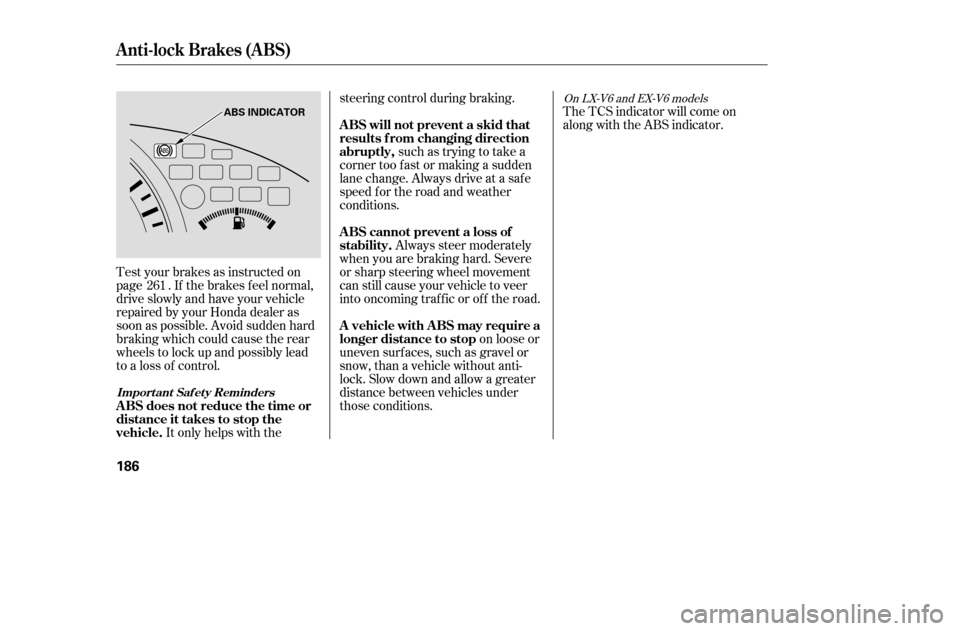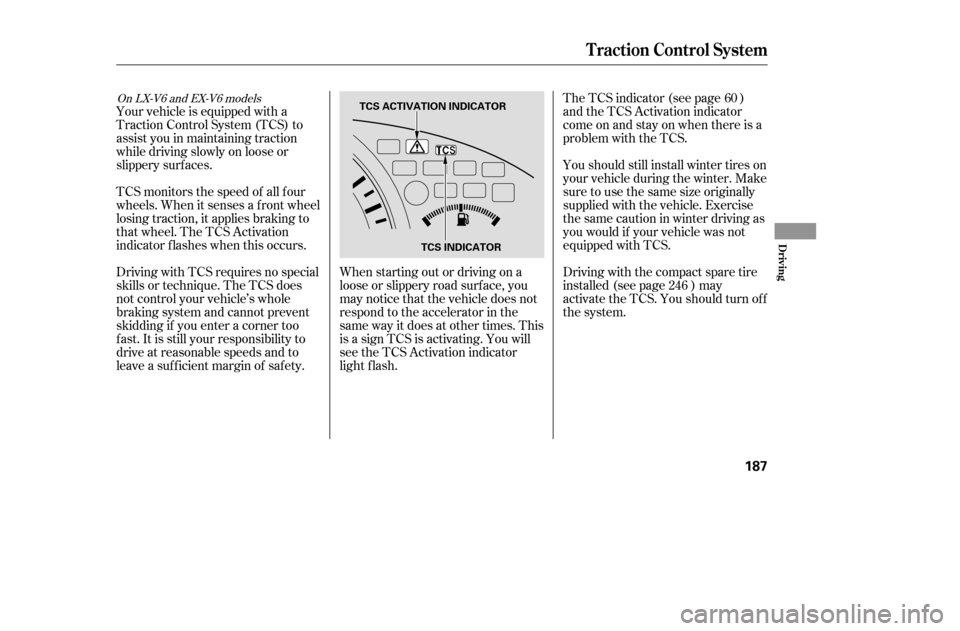Page 175 of 289

Always use the parking brake when
you park your vehicle. Make sure
the parking brake is set f irmly or
your vehicle may roll if it is parked
on an incline.
If your vehicle has an automatic
transmission, set the parking brake
bef ore you put the transmission in
Park. This keeps the vehicle f rom
moving and putting pressure on the
parking mechanism in the
transmission.Make sure the moonroof (if
equipped) and the windows are
closed.
Turn of f the lights.
Place any packages, valuables, etc.,
in the trunk or take them with you.
Lockthedoorswiththekeyorthe
remote transmitter.
Check the indicator on the
instrument panel to verif y that the
security system is set.
Never park over dry leaves, tall
grass, or other f lammable
materials. The hot three way
catalytic converter could cause
these materials to catch on fire.
If your vehicle has a manual
transmission, put it in f irst gear.
Make sure the parking brake is
f ully released bef ore driving away.
Driving with the parking brake
partially set can overheat or
damage the rear brakes.
If the vehicle is f acing uphill, turn
the f ront wheels away f rom the
curb. If your vehicle has a manual
transmission, put it in f irst gear.
If the vehicle is f acing downhill,
turn the front wheels toward the
curb. If your vehicle has a manual
transmission, put it in reverse gear.
On EX, LX-V6, and Canadian LX-G
models
Parking T ips
Parking
Driving
183
�����—�����—�����y�
����
��������y���
�(�����������y���
�����y
Page 176 of 289

Your vehicle is equipped with disc
brakes. The brakes on the rear
wheels may be disc or drum,
depending on the model. A power
assist helps reduce the ef f ort needed
on the brake pedal. The ABS helps
you retain steering control when
braking very hard.Check the brakes after driving
through deep water. Apply the
brakes moderately to see if they f eel
normal. If not, apply them gently and
f requently until they do. Be extra
cautious in your driving.
Constant application of the brakes
when going down a long hill builds
up heat and reduces their ef f ective-
ness. Use the engine to assist the
brakes by taking your f oot of f the
accelerator and downshif ting to a
lower gear.
Put your f oot on the brake pedal only
when you intend to brake. Resting
your f oot on the pedal keeps the
brakes applied lightly, builds up heat,
increases wear and reduces their
ef f ectiveness. It also keeps your
brake lights on all the time,
conf using drivers behind you.
If the brake pads need replacing, you
will hear a distinctive, metallic
screeching sound when you apply
the brake pedal. If you do not have
the brake pads replaced, they will
screech all the time. It is normal f or
the brakes to occasionally squeal or
squeak when you apply them.
The f ront disc brakes have audible
brake wear indicators. They are also
in the rear disc brakes of the EX,
EX-V6, and LX-V6 models.
The hydraulic system that operates
the brakes has two separate circuits.
Each circuit works diagonally across
the vehicle (the lef t-f ront brake is
connected with the right-rear brake,
etc.). If one circuit should develop a
problem, you will still have braking
at two wheels.
Braking System
Brake Wear Indicators
Braking System Design
184
�����—�����—�����y�
����
��������y���
�(�����������y���
�����y
Page 178 of 289

Test your brakes as instructed on
page . If the brakes f eel normal,
drive slowly and have your vehicle
repaired by your Honda dealer as
soon as possible. Avoid sudden hard
braking which could cause the rear
wheels to lock up and possibly lead
to a loss of control.such as trying to take a
corner too f ast or making a sudden
lane change. Always drive at a safe
speed f or the road and weather
conditions.
It only helps with the steering control during braking.
Always steer moderately
when you are braking hard. Severe
or sharp steering wheel movement
can still cause your vehicle to veer
into oncoming traffic or off the road.
on loose or
uneven surf aces, such as gravel or
snow, than a vehicle without anti-
lock. Slow down and allow a greater
distance between vehicles under
those conditions. The TCS indicator will come on
alongwiththeABSindicator.
261
On LX-V6 and EX-V6 models
Anti-lock Brakes (ABS)
A BS will not prevent a skid that
results f rom changing direction
abruptly,
A BS does not reduce the time or
distance it takes to stop the
vehicle. A BS cannot prevent a loss of
stability.
A vehicle with A BS may require a
longer distance to stop
Import ant Saf et y Reminders
186
ABS INDICATOR
�����—�����—�����y�
����
��������y���
�(�����������y���
�����y
Page 179 of 289

Your vehicle is equipped with a
Traction Control System (TCS) to
assist you in maintaining traction
while driving slowly on loose or
slippery surf aces.
TCS monitors the speed of all f our
wheels. When it senses a f ront wheel
losing traction, it applies braking to
that wheel. The TCS Activation
indicator f lashes when this occurs.
Driving with TCS requires no special
skills or technique. The TCS does
not control your vehicle’s whole
braking system and cannot prevent
skidding if you enter a corner too
f ast. It is still your responsibility to
drive at reasonable speeds and to
leave a sufficient margin of safety.When starting out or driving on a
loose or slippery road surf ace, you
may notice that the vehicle does not
respond to the accelerator in the
samewayitdoesatothertimes.This
is a sign TCS is activating. You will
seetheTCSActivationindicator
light f lash.TheTCSindicator(seepage )
andtheTCSActivationindicator
comeonandstayonwhenthereisa
problem with the TCS.
You should still install winter tires on
your vehicle during the winter. Make
sure to use the same size originally
supplied with the vehicle. Exercise
the same caution in winter driving as
you would if your vehicle was not
equipped with TCS.
Driving with the compact spare tire
installed (see page ) may
activate the TCS. You should turn of f
the system.
60
246
On LX-V6 and EX-V6 models
Traction Control System
Driving
187
TCS ACTIVATION INDICATOR TCS INDICATOR
�����—�����—�����y�
����
��������y���
�(�����������y���
�����y
Page 180 of 289
This switch is under the side vent. It
letsyouturntheTCSonandoff.You
cannot turn of f the TCS while the
TCS Activation indicator is f lashing.The TCS turns on every time you
start the engine, even if you turned it
off the last time you drove the
vehicle.
This indicator comes on or f lashes
under the f ollowing conditions:
Deactivate the system by pressing
the TCS On/Off switch. The TCS
Activation indicator comes on as a
reminder. Pressing the switch again
turns the system back on. When you turn the ignition switch
to ON (II).
When you manually turn of f TCS.
It f lashes when TCS is regulating
wheelspin.
If the system’s diagnostics senses
a problem with TCS, the indicator
will come on and stay on along
with the TCS Activation indicator.
Traction Control System
TCS ON/OFF Switch TCS Activation Indicator
188
�����—�����—�����y�
����
����
���y���
�(�����������y���
���
�y
Page 186 of 289

When preparing to tow, and bef ore
driving away, be sure to check the
f ollowing:The vehicle has been properly
serviced, and the tires, brakes,
suspension, cooling system, and
lights are in good operating
condition. Your vehicle tires and spare are
properly inf lated (see page ),
and the trailer tires and spare are
trailer maker.
Crosswinds and air turbulence
caused by passing trucks can disrupt
your steering and cause trailer
swaying. When being passed by a
large vehicle, keep a constant speed
and steer straight ahead. Do not try
to make quick steering or braking
corrections. Always drive slowly and have
someone guide you when backing up.
Grip the of the steering
wheel; then turn the wheel to the lef t
to get the trailer to move to the lef t,
andturnthewheelrighttomovethe
trailer to the right.
Follow all normal precautions when
parking, including f irmly setting the
parking brake and putting the
transmission in Park (automatic) or
in 1st or Reverse (manual). Also,
place wheel chocks at each of the
trailer’s tires.
The lights and brakes on your
vehicle and the trailer are working
properly.
All items in or on the trailer are
properly secured and cannot shif t
while you drive.
Thehitch,safetychains,andany
other attachments are secure.
All weights and loads are within
limits (see pages and ).
190 191 236
bottom
Pre-T ow Checklist
Handling Crosswinds and Buf f et ing
Backing Up
Parking
Towing a Trailer
194
�����—�����—�����y�
����
����
���y���
�(�����������y���
�����y
Page 216 of 289
�µ�µ
Always use Honda Power Steering
Fluid. You may use another power
steering f luid as an emergency
replacement, but have the power
steering system f lushed and ref illed
with Honda PSF as soon as possible.
A low power steering f luid level can
indicate a leak in the system. Check
the f luid level f requently, and have
the system inspected as soon as
possible.
The timing belt should be replaced
at the intervals shown in the
maintenance schedule. Replace the
belt at 60,000 miles (100,000 km) if
you regularly drive your vehicle in
one or more of these conditions:
In very high temperatures
(over 110°F, 43°C).
In very low temperatures
(under 20°F, 29°C).
Frequently tow a trailer.
6-cylinder models only
Power Steering Fluid, T iming Belt
T iming Belt
Maint enance
225
T urning the steering wheel to f ull lef t
or right lock and holding it there can
damage the power steering pump.
�����—�����—�����y�
����
��������y���
�(�����������y���������y
Page 219 of 289
Push the electrical connector onto
the bulb.To change the passenger’s side
bulb, start the engine, turn the
steering wheel all the way to the
lef t, and turn of f the engine. To
change the driver’s side bulb, turn
the steering wheel to the right.Pull the inner f ender cover away
f rom the f ender and bumper.
Remove the bulb by turning it
approximately one-quarter turn
counterclockwise.
Remove the electrical connector
fromthebulbbysqueezingthe
connector to unlock the tab, then
slide the connector of f the bulb.
Use a f lat-tipped screwdriver to
remove the two holding clips f rom
the inner f ender.
Turn on the headlights to test the
new bulb.
(Passenger’s side)
Reinstall the air intake cover.
Reinstall the two fasteners and
secure them by pushing on the
heads until they lock.
6.
5.
3. 4. 5.
1. 2.
7.
Lights
L ow Beam Headlight
228
HOLDING CLIPS
TAB BULB
6-cylinder models BULB
�����—�����—�����y�
�������������y���
�(�����������y�������
�y